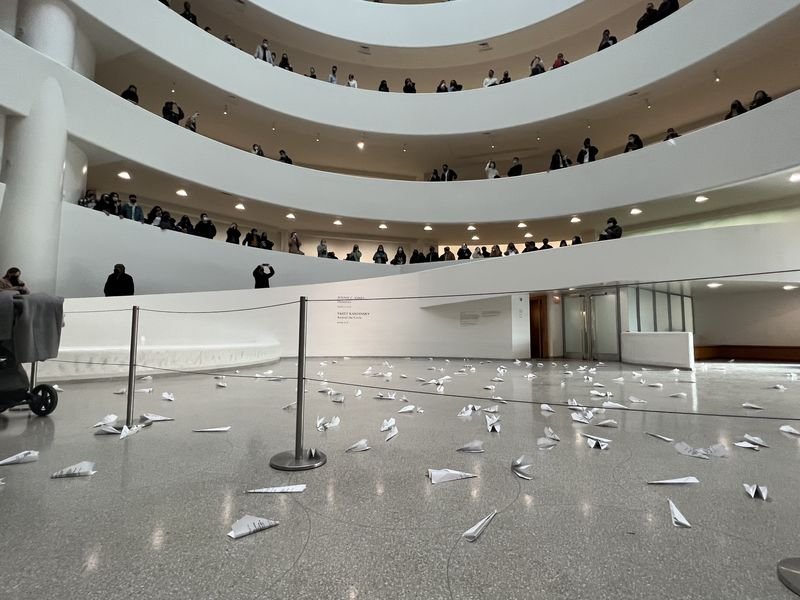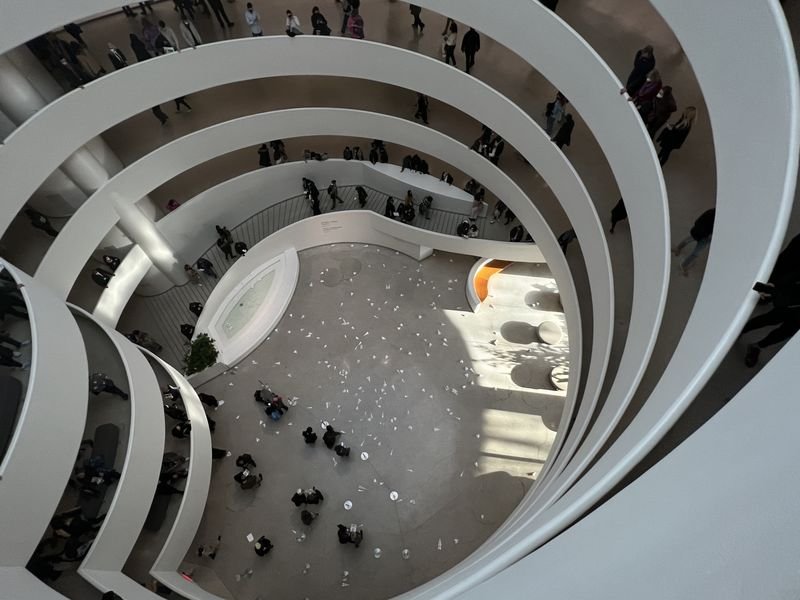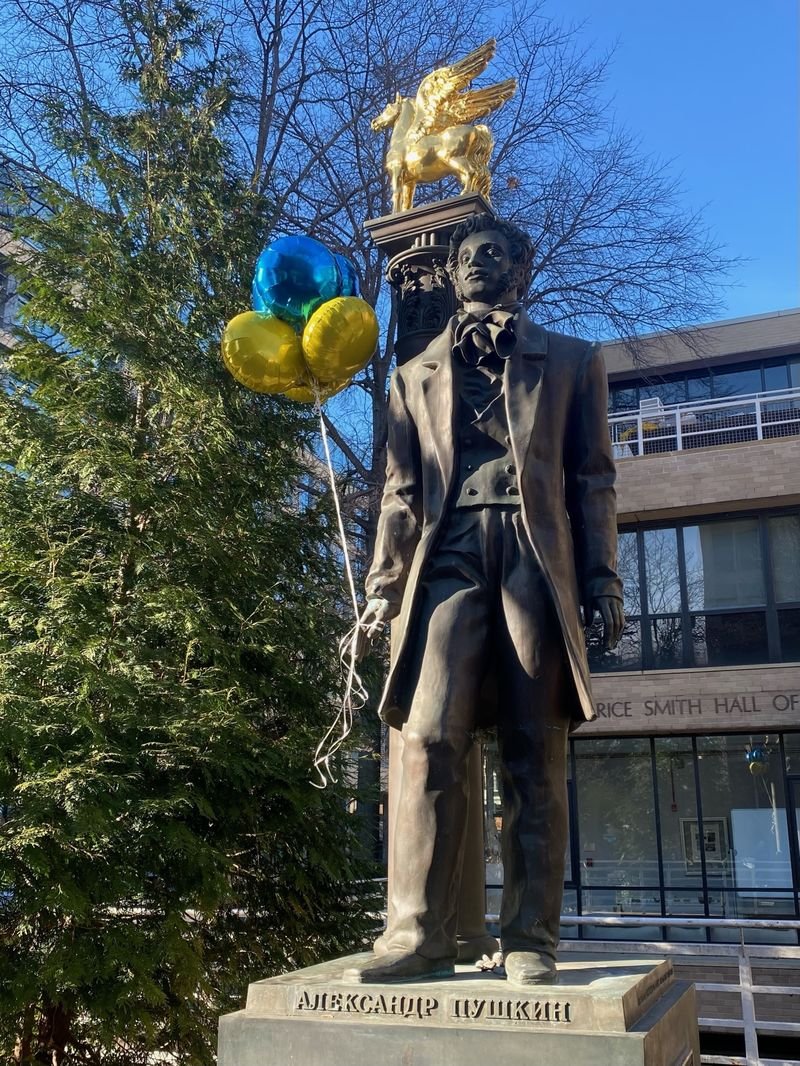How Artists and Museums Are Responding to Russia’s War in Ukraine

Written by Maxwell Adler and Kriston Capps. originally published by Bloomberg CityLab+ Pursuits, 11 March 2022.
Katya Pavlevych and a group of fellow Ukrainian artists living in New York City dropped hundreds of paper planes over the ledges of the gently sloped spiral ramp that wraps around the Solomon R. Guggenheim Museum. The planes whirled their way through the air before landing on the rotunda floor where museum patrons unfolded them, read their contents and erupted into applause.
“This jet is made of paper. But what if it were made of steel… And carried bombs… over the heads of the ones you love,” read the letter on the inside of the paper planes, referencing Russian President Vladimir Putin’s invasion of Ukraine.
“We wanted to show people what it feels like when danger comes from the sky,” said Lika Volk, one of the organizers of the March 5 ‘paper planes’ protest. “We are asking the West to just do something.”
Artists, like Pavlevych, Volk and their friends, are stepping up to lead the efforts to preserve Ukrainian culture and protest its destruction. Similarly, museums across the world are staging symbolic displays of solidarity with Ukraine or distancing themselves from benefactors who hail from Russia. The impact could be long-lasting for art institutions in the U.S. and Europe, who have enjoyed lucrative friendships with Russia’s powerful tycoons, and now may change course.

The spirited scene at the Guggenheim on Saturday stood in stark contrast to the destruction being levied across Ukraine by the invading Russian troops. Despite international restrictions on the conduct of war, Ukraine’s cultural institutions have not been spared. The Museum of Local History in Ivankiv was reduced to rubble after being set on fire by Russian forces, according to Ukraine’s Ministry of Foreign Affairs. The walls at Lviv’s National Museum stood bare as Ukrainians raced to save the museum’s cultural treasures. And Maria Lanko, a curator of the Ukrainian Pavilion’s exhibition at the upcoming 2022 Venice Biennale, was forced to load up the artwork destined for display at the festival into the backseat of her car and drive it safely into Poland.
Just days before the unofficial action at the Guggenheim, the museum announced that Vladimir Potanin was stepping down from his role as a museum trustee. One of the wealthiest men in Russia, Potanin has been one of the Guggenheim’s most influential benefactors for the past two decades, sponsoring several exhibitions including a survey of paintings by Vasily Kandinsky on view now. The museum named a conservation fellowship after Potanin in 2019. He has also given generously to the John F. Kennedy Center for the Performing Arts in Washington, D.C. His company, Interros Holding Co., donated $6.45 million to the Kennedy Center in 2011, and the Vladimir Potanin Foundation donated $450,000 to the Kennedy Center in 2016.

Other Russians have departed museum posts as scrutiny builds over their connections to Putin. Petr Aven — an Alfa Group investor described by European Union sanctions documents as “one of Vladimir Putin’s closest oligarchs” — resigned as a trustee from the Royal Academy of Arts in London on March 2. The New York Times reports that the museum returned his donation toward an ongoing exhibition of Francis Bacon. Aven called on Russia to end its war immediately in a statement to Bloomberg News, but stopped short of criticizing Putin.
Meanwhile, multiple high-profile leaders have either left their positions at Russian art and cultural institutions, or have been forced out because of their opposition to Russia’s invasion. Vladimir Opredelenov, former deputy director of the Pushkin Museum in Moscow, resigned his post and issued a statement on Instagram that read in part: “My attitude to current world events does not coincide with that of my colleagues from the Ministry of Culture of the Russian Federation. I hope this will change in the near future, but with things as they are, I am forced to leave my beloved museum.” Francesco Manacorda, the former artistic director of the VAC Foundation in Moscow, also resigned, citing “current world events” as a reason for his decision. And Simon Rees, former artistic director of the Cosmoscow Art Fair, cut ties with his institution.
As with luxury real estate and Facebook trolls, Russia’s influence in U.S. museums is broad. More resignations may be in the works. An investigation into post-Soviet business philanthropy by the nonprofit Anti-Corruption Data Collective found that seven of the people whose names surfaced in Special Counsel Robert Mueller’s report into Russia’s interference in the 2016 U.S. presidential election together gave between $372 million and $435 million to U.S. institutions and nonprofits, including the Museum of Modern Art in New York and the Kennedy Center.
The Ukrainian-born Russian tycoon Mikhail Fridman gave the Kennedy Center $1.25 million in 2019, for example. Earlier this year, the venue quietly rechristened the "Russian Lounge" named after Potanin's gift as the “Circles Lounge.” The Kennedy Center is currently lit in the colors of the Ukrainian flag and will hold a free concert of Ukrainian music on Saturday.
War has not entirely disrupted Russia’s footing in the art world. Facing calls for a boycott, the Russian-owned auction house Phillips announced it would donate all buyers and sellers’ premiums for its March 3 modern and contemporary art sale to the Ukrainian Red Cross Society. Sales that evening cleared $40 million.

But other art institutions in Russia, and Russian artists themselves, are already paying the price for Putin’s war. Ragnar Kjartansson, Constant Dullaart and Anton Vidokle are among the international artists who have pulled out of Russian exhibitions. Moscow’s Garage Museum of Contemporary Art, an elite museum cofounded by soon-to-be-ex-Chelsea F.C. owner Roman Abramovich, announced that it would stop work on all its exhibitions until Russia ended the war. Russian artists Kirill Savchenkov and Alexandra Sukhareva, who were slated to represent Russia at the Venice Biennale this summer, announced their withdrawal from this year’s festival, effectively self-canceling the Russian pavilion.
Russian artists who count themselves among Putin’s critics, including many living abroad, are taking action to protest his regime. Mark Kelner, a Russian-American artist based in D.C., tied yellow and blue balloons to a Washington statue of Alexander Pushkin, “the poet whose work is most rooted in the idea of the Russian identity,” Kelner said.
Ukraine-born, New York–based artists Ilya and Emilia Kabakov told Artnet News that they don’t support the “cultural sanctions” being levied against Russian performers and venues. Olga Kisseleva, a Russian artist who works in Paris, is collaborating with Ukrainian artist Taisya Polichuk on a video piece for an upcoming show in Paris. Andrei Molodkin, another Russia-born artist based in Paris, told Artnet that a soft ban on Russian artists is “Putin’s dream.”
Indeed, in its condemnation of the war, the U.K.’s Museums Association called on members first and foremost to provide a platform for Ukrainian artists and curators, and to make space for debate and reflection. The statement also asked museums to “consider the ethical implications” of loaning works to or accepting sponsorship from Russia.
For its part, MoMA in New York published drawings on its website about the run-up to the invasion of Ukraine by Anna Sarvira, an illustrator who was forced to flee her home in Kyiv.
The Smithsonian Institution in the U.S. says that is communicating with partners in Ukraine through its Cultural Rescue Initiative. The Cultural Heritage Monitoring Lab, a partnership between the Smithsonian and the Virginia Museum of Natural History, is using geospatial data to track the impact of war on museums and institutions. And the Smithsonian is also working with the interagency Cultural Heritage Coordinating Committee, which is chaired by the U.S. State Department.
The action at the Guggenheim was not the week's only high-profile art protest. The cellist Yo-Yo Ma staged an unofficial concert on March 8 outside the Russian Embassy in D.C. as a show of solidarity with Ukraine.
In this ongoing emergency, the hard work falls on artists, curators and cultural stewards who are wrapping statues in Ukraine or mounting protests abroad. Artists have a storied history of confronting important political and social issues in order to expose hypocrisies and help create a more peaceful future. The protest movement against Putin’s invasion will continue to be shaped and influenced by the art world — while the art world may finally begin to shed some of Putin’s influence.
“We won’t stop protesting as long as the war goes on,” said Volk.